What are the best handicrafts of Iran?
Are you familiar with the best handicrafts of Iran? Iran is a vast country that has different tribes and cultures in every corner of this land. Each region has different customs and culture according to its geographical location, weather and past history.
Lor, Kurd, Turk, Baloch, Arab, and also different provinces have their own handicrafts according to their geographical and cultural location.
So it is clear that the handicrafts of our beloved country have a very high diversity.
In the following, we will discuss the most popular handicrafts in Iran
Weaving and textile handicrafts
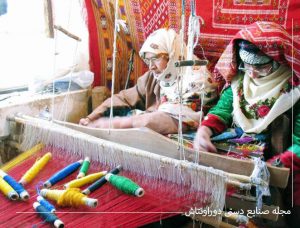
Weaving and traditional weaving are among the oldest handicrafts of Iran. This industry was formed in order to meet the human need for clothing and some daily items and was divided into different branches. Today, traditional weaving and textile industry can be considered as one of the most diverse handicrafts in Iran. In different provinces of our country, the weaving of various types of carpets and rugs and different types of traditional textiles are popular, which are among the most famous handicrafts of these regions. Some of the sub-branches of this industry are: gabe weaving, jajim weaving, silk weaving, night tent weaving, velvet weaving, curtain weaving, khos weaving, bar weaving, shamad weaving and chafieh weaving.
Handicrafts of mat weaving
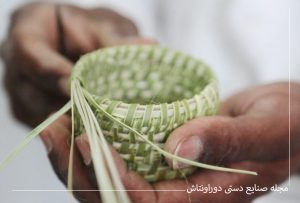
Carpet weaving is another old handicraft of Iran that is popular in the south and north of our country. Today, they use all kinds of wicker handicrafts as souvenirs. Although the mat weaving industry can be considered as one of the sub-branches of wooden handicrafts, the extent of this branch and its high position in the handicraft market has made it a separate branch in this industry.
To make wicker works in different parts of the country, they use palm leaves, wheat stalks, reeds and all kinds of leaves. Wicker items are highly used in people’s daily life, especially in areas with high humidity. Tasteful artists produce various works by dyeing the mat and combining it with colored threads. Among the subcategories of the art of rattan weaving, we can mention kapobafi, buria weaving, pearl weaving, bomba weaving, and basket weaving. Here you can see and buy examples of wicker baskets known as kapu.
Metal crafts
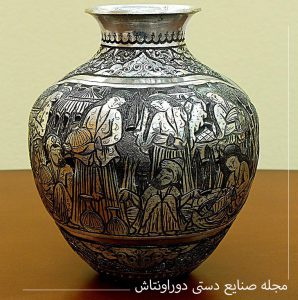
The discovery of metal in the ancient times drew people’s attention to this first material for the manufacture of daily necessities, and its use to prepare all kinds of utensils and everyday tools became common due to the high strength of this material. Among the works left from ancient Iran, there are many examples of all kinds of metal tools. For this reason, the age of metal crafts can be attributed to ancient Iran.
Traditional dyeing and dyeing crafts
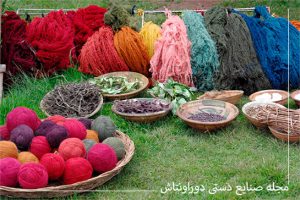
The art of traditional dyeing and dyeing emerged after the development of weaving industries. The reason for the formation of these handicrafts was the human desire for high color diversity in the production of various types of knitwear such as carpets and clothes. In traditional dyeing, natural colors were produced by using natural plant seeds and combining them with each other. Among the most important plants that can be used in this branch, we can mention runas, pomegranate, onion and mountain oil. Different insect larvae were also used in the traditional dyeing method.
Over time and with the increasing skill of dyers in making various colors, they used this art in architecture, woodwork, various textures and paper industries. Even today, traditional dyeing industries are widely used due to its naturalness.
Handicrafts of kilim weaving
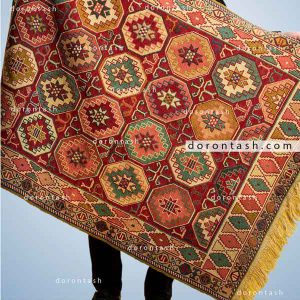
pesrian kilim bags is one of the famous handicrafts of Iran, which has gained many fans in Yemen for several years
Iranian rug is the best-selling handicraft product of our country. Carpets from different regions of the country have their fans, and Iranian hand-woven carpets still have a good domestic market.
The first flooring of primitive man was animal skin. But after the passage of thousands of years, when he was able to gradually shape the raw materials of nature to his will, he thought of making an upper covering for himself and a floor covering for his residence. The first man-made floor coverings are mats and burias, and gradually he learned the texture of wool.
Carpet weaving is particularly popular in most parts of Iran, especially among the Qashqais, Al Sons, Kurds, Lors and Baluchs. Belfa carpet, like many different fields of rural handicrafts, is specific to women, and Iranian nomadic and rural women create pleasant patterns and colorings that are perfect in their own way.
Other popular handmade products in the Iranian market are copper and glass dishes. A significant part of the sales of the traditional markets of Isfahan and Shiraz belong to copper handicrafts. Pottery and ceramic artefacts are also popular among tourists and many travelers buy these handicrafts for souvenirs. Various types of embroidering, enameling, handmade ornaments, crocheting and embroidery are also among the best-selling handicrafts in different cities of Iran.
carpet or rug
Iranian carpet
Iranian carpet or Iranian carpet is the most famous and important handicraft of Iran, which dates back to the Achaemenid period. Iranian hand-woven carpets have long been famous, and nowadays they are bought and sold at the global level. Carpet plays a very important role in the culture and art of Iran, and its exquisite examples have become a piece of art that can be displayed in museums, or in the form of carpets, a spectacular effect for houses and mansions. they forgive
Most Iranian carpets are usually made of wool; But the best and most expensive types of carpets are those that have a silk texture. Iranian carpets are woven in a variety of designs and colors, the most famous of which are Shah Abbasi design, Slimi design, Bete Jaqeh design, tree design, Ili and Nomadic design, and geometric design.
Pottery
In the next step, we go to the ancient art of pottery. Pottery has been associated with Iranian people for a long time and is still known as a valuable handicraft among Iranians and foreign tourists.
Pottery, as you know, is the art of making containers with mud, and this type of handicraft in Iran is more than 10,000 years old. Susa hosts the oldest pottery wheel and pottery kiln in the world, and the world’s oldest engraved pottery vessels have also been found in Iran.
Warsaw
Warsaw is actually making ornaments or containers from Warsaw alloy metal, which is generally a combination of 20% nickel, 35% zinc and 45% copper.
The art of Warsaw-making came to Iran from Poland, and in fact, the art of Warsaw-making came from Poland to Iran, located in Warsaw, and the name of Warsaw has been preserved on this metal because of the city of Warsaw, the center of Poland.
Warsaw construction in Iran dates back to the Safavid era. But the art of waxing became very prosperous in the late Qajar and Pahlavi times, and they were very prosperous in the cities of Borujerd and Dezful in Iran.
After the art of Warsaw-making entered Iran, Dezfuli and Boroujerdi artists softened and shaped the Warsaw alloy and left it in the hands of pen artists, and many beautiful works of Warsaw were created.
Another one of these prominent Warsaw artists, whose father was a Russian Warsaw maker, moved to Ardabil due to the prosperity of Warsaw in Iran and even chose the name Warsaw. His son died as the last Warsaw artist in Ardabil a few years ago. The Warsaw industry in the late Qajar era and early The Pahlavi era reached its peak in Iran, especially in the cities of Dezful and Borujerd.
Khatamkari
Khatamkari is a type of wooden handicraft and its production is popular in Isfahan, Shiraz and Tehran. To make a seal, regular polygons of different materials are put together to finally reach the final shape they want. Khatam is sold in various colors and various raw materials with different colors are used in its construction. Making a seal takes a lot of time from the seal artist and requires a lot of precision. Wooden materials such as walnut, juniper, ebony and various types of bone such as elephant ivory, camel bone and horse bone are usually used in making Khatam.
Enamels
Minakari or Minagri is one of the most important handicrafts of Iran with a history of 5000 thousand years. Enameling is placed in the group of metal handicrafts and can be performed on metals such as copper, gold and silver. Most of us know enameling as azure blue, but enameled dishes in gold, green, yellow, black and pink can also be seen in the market. Isfahan is the heart of enameling in the world and the best examples of enameling are made in this city.

